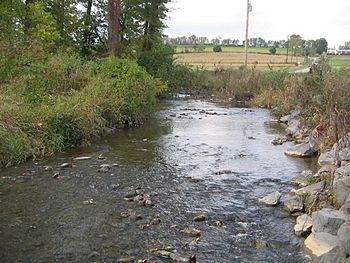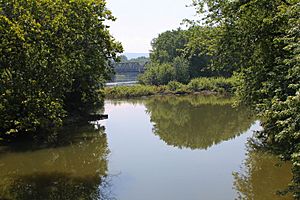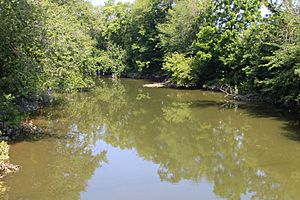Buffalo Creek (West Branch Susquehanna River tributary) facts for kids
Quick facts for kids Buffalo Creek |
|
|---|---|

Buffalo Creek from the Hayes Bridge in West Buffalo Township, Union County, Pennsylvania
|
|
| Physical characteristics | |
| Main source | Branch Mountain in Hartley Township, Union County, Pennsylvania between 2,080 and 2,100 feet (630 and 640 m) |
| River mouth | West Branch Susquehanna River on the border between Lewisburg, Union County, Pennsylvania and Kelly Township, Union County, Pennsylvania between 420 and 440 feet (130 and 130 m) 40°58′09″N 76°52′57″W / 40.9693°N 76.8824°W |
| Length | 28.5 mi (45.9 km) |
| Basin features | |
| Progression | West Branch Susquehanna River → Susquehanna River → Chesapeake Bay |
| Basin size | 134 sq mi (350 km2) |
| Tributaries |
|
Buffalo Creek is a cool stream in Union County, Pennsylvania, United States. It flows into the West Branch Susquehanna River. The creek is about 28.5 miles (45.9 km) long. It winds through several towns like Mifflinburg and Lewisburg.
The area around Buffalo Creek, called its watershed, covers about 134 square miles (350 km2). This region is part of the Appalachian Mountains, known for its ridges and valleys. Some parts of the creek are great for fishing, especially for cold-water fish. The forests here are mostly made up of hardwood trees, hemlock, and pine.
The water in Buffalo Creek is a bit acidic, with a pH usually between 5.0 and 6.7. You can find minerals like magnesium and calcium carbonate in the water. There's also dissolved oxygen, which fish need to breathe, and other things like phosphorus.
No one really knows how Buffalo Creek got its name. Even though it's called "Buffalo Creek," there's no clear proof that buffalo ever lived here. But some people say there are old "buffalo wallows" (muddy spots where buffalo rolled) along the creek. Other places nearby, like Buffalo Township and Buffalo Mountain, are also named after the creek. In the past, people used the creek for mills and cutting down trees. Today, farming and raising animals are more common.
Contents
Where Does Buffalo Creek Flow?
Buffalo Creek starts in Hartley Township, near the border with Centre County. It flows east and a little north, passing between Buffalo Mountain and Branch Mountain. Then, it drops sharply through two cool spots called the Gooseneck and Buffalo Gap.
After that, the creek turns southeast and leaves Hartley Township. It enters Lewis Township and gently curves eastward, south of Jones Mountain. It even flows through the Mifflinburg Reservoir. Next, it goes into southern West Buffalo Township and northern Mifflinburg. Just before leaving West Buffalo Township, another stream, North Branch Buffalo Creek, joins it. The creek briefly turns north, then east again, leaving the township.
When Buffalo Creek leaves West Buffalo Township, it flows into Buffalo Township. It then turns northeast, passing by the community of Cowan and under Pennsylvania Route 192. The creek then picks up its tributary, Stony Run, and later Spruce Run. At this point, Buffalo Creek flows along the edge between Buffalo Township and Kelly Township.
Buffalo Creek then winds eastward, passing a quarry, the community of Kelly Point, and the Lewisburg Federal Penitentiary. After leaving Buffalo Township, the creek flows briefly along the border between Kelly Township and Lewisburg. Finally, it empties into the West Branch Susquehanna River. Buffalo Creek joins the West Branch Susquehanna River about 7.73 miles (12.44 km) upstream from its mouth.
What Are Buffalo Creek's Tributaries?
A tributary is a smaller stream or river that flows into a larger one. Buffalo Creek has six named tributaries:
These smaller streams join Buffalo Creek at different points along its path, adding to its water flow. For example, Little Buffalo Creek joins about 3.30 miles (5.31 km) from the mouth of Buffalo Creek.
How Healthy is the Water?
Scientists measure the water quality of Buffalo Creek. The pH of the water, which tells us how acidic or basic it is, usually ranges from 5.0 to 6.7. A pH of 7 is neutral, so Buffalo Creek is slightly acidic. The water temperature also changes, getting a bit warmer as the creek flows from its source to its mouth.
The amount of dissolved oxygen in the water is important for fish and other aquatic life. In Buffalo Creek, it's usually between 8.5 and 11 milligrams per liter. This level generally supports healthy aquatic life.
Minerals like magnesium and calcium carbonate are also found in the water. Their levels change along the creek's path, often increasing in the middle sections. For example, calcium carbonate can reach 100 milligrams per liter near Mifflinburg.
The amount of phosphorus in the water is usually low in the upper parts of the creek. However, it can be higher in some spots, especially where Buffalo Flat Road crosses the creek. Too much phosphorus can cause problems like too much algae growth.
The creek also carries suspended solids, which are tiny bits of dirt and other materials floating in the water. The amount of these solids changes a lot, with higher levels sometimes seen near Mifflinburg and Lewisburg.
Scientists also check for ammonium and nitrogen in the water. These can come from pollution. The levels of some substances, like phosphorus, have increased in certain parts of the creek since 2009.
Some parts of Buffalo Creek and its smaller streams, like Coal Run and Rapid Run, are affected by farming activities. This means the water quality in these areas might not be as good as it could be.
What is the Land Like Around Buffalo Creek?
The land around Buffalo Creek changes from mountainous areas near its start to wide valleys in its lower parts. The creek's path is curvy and flows over different types of rocks, like sandstone and limestone. The entire area is part of the Ridge-and-Valley Appalachians, which means it has long, parallel ridges and valleys.
The rocks here are sedimentary rocks, which means they formed from layers of sediment over millions of years. Some of these rocks are very old and have been pushed and folded by Earth's movements. You can find different types of soil in the watershed, which affect how water soaks into the ground.
Near Mifflinburg, Buffalo Creek is described as "tiny and twisting." It's often shallow, even in deeper spots called stream pools. The creek usually flows gently over small rocky areas called riffles.
The Buffalo Creek valley is a central feature of the area. In the early 1900s, the region received about 40 to 45 inches (100 to 110 cm) of rain each year.
What is the Buffalo Creek Watershed?
The watershed of Buffalo Creek is the entire area of land where all the rain and snowmelt drain into Buffalo Creek and its tributaries. It covers about 134 square miles (350 km2) and includes parts of Union County and Centre County.
Most of the land in the watershed (60 percent) is covered by forests, especially in the Bald Eagle State Forest. About 34 percent of the land is used for agriculture, mostly near Lewisburg and Mifflinburg. The remaining 6 percent is for homes, towns, and industries.
The watershed gets about 42 inches (110 cm) of rain on average each year, and the average temperature is 51 °F (11 °C). Around 15,000 people live in the watershed. The largest town within the watershed is Mifflinburg.
The upper parts of Buffalo Creek can be acidic because of the natural rocks there. The watershed also has floodplains (flat areas that can flood) and wetlands (areas where water covers the soil).
Two reservoirs, which store water, are located in the watershed. One is on North Branch Buffalo Creek and provides water for Mifflinburg. The other is on Spruce Run and supplies water for the Pennsylvania-American Water Company. Major roads like Pennsylvania Route 45 and Pennsylvania Route 192 run through the watershed.
A Look Back at Buffalo Creek's History
The name "Buffalo Creek" is a bit of a mystery. In the 1700s, there were many streams called Buffalo Creek in Pennsylvania, even though there weren't many buffalo in the state. Some local stories say that dips in the ground near Cowan are old buffalo wallows, but there's no strong proof.
In the 1700s, the Buffalo Creek watershed was a frontier area, meaning it was newly settled. Many forts were built here, like Fort Titzell. In 1769, the land was opened for settlers, and people like John Sierer began to arrive. A famous Revolutionary War soldier, Colonel John Kelly, built his home along the creek.
In the early 1800s, people built sawmills (to cut wood) and gristmills (to grind grain) along the creek. By 1788, there was already a mill here. Many small mills made things like flour, cider, and wool. There was even a log schoolhouse on Buffalo Creek in the 1830s. Later in the 1800s, the lumbering industry grew, which led to railroads being built. This industry became less important in the early 1900s.
In the early 1900s, the main jobs in the watershed were farming, furniture making, flour mills, and brick making. The creek was also used to power some small mills. Today, the population of the watershed is growing, and farming and raising animals are the main industries.
Animals and Plants of Buffalo Creek
The Buffalo Creek watershed is a great place for wildlife. Some parts of the creek are known as "High-Quality Coldwater Fisheries," which means the water is cold and clean enough for special fish like trout. Wild trout naturally reproduce in the creek for about 13.76 miles (22.14 km) from its source. In fact, half of the approved trout fishing spots in Union County are in this watershed!
You can spot many different birds here, including raptors (like hawks), waterfowl (like ducks), songbirds, and wild turkeys. Many mammals also live in the watershed, such as foxes, raccoons, opossums, skunks, white-tailed deer, and even black bears.
The forests are mostly made up of deciduous hardwood trees, which lose their leaves in the fall. But you'll also see some hemlock and pine trees.
Scientists study tiny creatures called macroinvertebrates (like insect larvae) in the creek. Finding many different types of these creatures usually means the stream is healthy. The studies on Buffalo Creek show it's a relatively healthy stream.
However, studies in 2011 found higher levels of bacteria in the water, especially fecal coliform and enterococcus. These bacteria can come from humans and farm animals like cows and pigs. This means the water might not be safe for swimming, even though it's a beautiful place. Reducing the amount of bacteria from farm animals could make the creek much safer.
Fun Things to Do at Buffalo Creek
Buffalo Creek offers some cool outdoor activities! The lower 14.8 miles (23.8 km) of the creek, from Mifflinburg to Lewisburg, is good for canoeing when there's enough water, like after snow melts or a heavy rain. It's considered an easy creek for canoeing.
Many people enjoy fishing in Buffalo Creek, especially for trout. It's also a popular spot for birdwatching. Besides these, you can enjoy driving through the scenic area, cross-country skiing in winter, horseback riding, mountain biking, and camping.
While the creek is great for many activities, the levels of bacteria in the water are higher than what's considered safe for swimming. So, it's best to enjoy the creek from its banks or in a canoe, rather than swimming in it.





